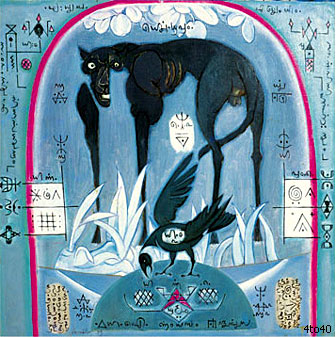 K. C. S. Paniker (1911-1977) was one of the best metaphysical and abstract painters in India, took to interpreting the country’s age-old metaphysical and spiritual knowledge in the 60s, when Indian art was still under the influence of the western painters. “That was the time when a few Indian artists were trying to break out of this Western influence and establish an idiom and identity of their own,” he once said.
K. C. S. Paniker (1911-1977) was one of the best metaphysical and abstract painters in India, took to interpreting the country’s age-old metaphysical and spiritual knowledge in the 60s, when Indian art was still under the influence of the western painters. “That was the time when a few Indian artists were trying to break out of this Western influence and establish an idiom and identity of their own,” he once said.
In 1976, he was awarded the highest award of the Lalit Kala Akademi, India’s National Academy of Art, the Fellow of the Lalit Kala Akademi for lifetime contribution.
Early life and education
Born in Coimbatore on May 31, 1911, and received his school education in Kerala and later in Tamil Nadu, the lush green village in which Panicker lived influenced the colourful landscapes of his early years. The bright colours stayed in his paintings, even though he moved away from landscapes onto other things.
A virtual child prodigy, Panicker began painting landscapes when he was only 12. By the age of 17, he was already exhibiting at the Madras Fine Arts Society’s annual shows. Somewhere in 1918, he gave up college education to take up a job at the Indian Telegraph Department to support his family after the death of his father.
It was not until the age of 25 that he joined the Government School of Arts and Crafts, Chennai (1936-40).
Career
Since 1941, Panicker had been holding one man shows in Chennai and Delhi. He founded the Progressive Painters’ Association (P.P.A), in Chennai in 1944. It was only in 1954 that he got the first international exposure when he held exhibitions at London and Paris. He became the Principal of the Government College of Fine Arts, Chennai, in 1957, and in 1966 formed the Cholamandal Artists’ Village, 9 km from Chennai, along with his students and a few fellow artists.
The exhibitions’ abroad and his exposure to abstract artists like Salvador Dali had a major influence on his art. “They hark back to the weird, but spiritually uplifting figurative exaggerations of ancient Indian painting and sculpture,” Panicker said.
Yet, the colours he used were bright and sunny, the kinds of colors that you see in the paintings of the Impressionists. Somewhere down the line, Panicker moved on to use calligraphy and symbols to project a state of metaphysical abstraction.
KCS Panicker died in Chennai at the age 66 in January 1977.
Highlights
- 1911 Born on 31st May in Coimbatore, Tamil Nadu, India.
- 1917-30 Formal education in Kerala State and Tamil Nadu.
- 1936-40 Art education at the Government School of Arts and Crafts, Chennai.
- 1944 Establishment of the Progressive Painters’ Association, Chennai.
- 1954 One of the Nine Eminent Artists and Member of Executive Board of the Lalit Kala Academy, New Delhi; travels in Europe; one man exhibitions of paintings at the India House, London, and Paris.
- 1957 Appointed Principal, Government School of Arts and Crafts, Chennai.
- 1959 Extensive travel in USSR and talks on Indian art in Moscow, Leningrad, and Kiev.
- 1961 VIth Biennale de Sao Paolo.
- 1962 Participation in the Indian Art exhibition in Mexico; upgrading of the Government School of Arts and Crafts, Chennai to Government college of Arts and Crafts.
- 1963 Member, Indian Delegation, World Art Congress, New York; travel to USA and discussions with American artists as a guest of the State Dept, USA.
- 1964-67 Tokyo Biennale, Festival Hall Exhibition, London and the Venice Biennale; ; retirement in 1967 from the principalship of the Government College of Arts and Crafts, Chennai; the establishment of Cholamandal Artists’ Village, Chennai in 1966.
- 1977 Passes away in Chennai.
 Kids Portal For Parents India Kids Network
Kids Portal For Parents India Kids Network






